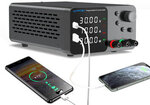WANPTEK Lab Bench Power Supply 300W Laboratory Switching Power Supply Unit 30V 10A Adjustable Digital Source 60V 5A for $US57.23 or ~$AUD86.78 after coupon : BGb2f101, delivered from China
Features:
- Small size, light weight and high power density.
- Constant pressure and constant current switch automatically.
- LED display of voltage, current and power, high precision and features of voltage stabilization, current limiting, and simple operation.
- Adjustable Output Voltage & Current: output voltage and output current can be continuously
- adjusted between 0 and nominal value with fine regulating and coarse regulating
- it has over voltage protection(OVP), over current protection(OCP), over temperature protection
- Temperature controlled fan cooling, low noise, long life.
- Dual voltage input and convenient choice.
- Output Voltage ranges from 0 to rating voltage with continuous adjustment .
- Output current ranges from 0 to rating current with continuous adjustment
- AC 110v and 220V
- Encoder adjustment DC power supply
- Voltage and current one-key conversion regulation
- Built-in cooling fan, Smart turn on when temperature over 50℃
FCC & CE certified product
Specifications:
- Output Power: 150W/300W/360W
- Output voltage: 0~30V/60V/120V
- Output current: 0~3A/5A/10A
Working environment:
input voltage:AC 230V/115V±10%;50Hz/60Hz
Working temperature:0℃~40℃;relative humidity:<80%RH
Storage temperature:-10℃~70℃;relative humidity:<70%RHConstant voltage CV:
Voltage stability:0.1%±3mV
Load stability: 0.2%±3mV
Ripple voltage:≤0.5% Vp-p
0 to rated voltage continuously adjustableConstant current CC:
Current stability:0.1%±3mA
Load stability: 0.2%±3mA
Ripple current:≤0.5% Vp-p
Recovery time:≤500μS
Temperature coefficient:≤100ppm/℃
0 to rated current continuously adjustable




Why would you need to control the pressure of the bench power supply?